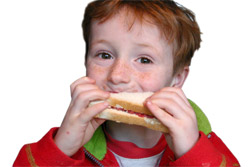Introduction to nutrition for children in primary school
- Nutritional needs of school-aged children
- What can parents do to help children eat healthily?
- Nutritional advice for school-aged children
- Nutritional problems in school-aged children
- Key points for good nutrition in primary school-aged children
Introduction to nutrition for children in primary school
Maintaining a balanced diet and regular exercise is important for all individuals, especially school-aged children (6-12 years). These children are required to eat a variety of foods from each food group to ensure optimal intake of all vitamins and minerals. At the same time, they may face new challenges regarding food choices and habits. Decisions about what to eat are partly determined by what is provided in school, at home, the influences from friends at school, and the media, especially television.
Poor nutrition compromises both the quality of life of school-aged children but also their potential to benefit from education. Attaining optimal nutrition involves eating three meals a day and two nutritious snacks, as well as limiting the intake of high sugar and high fat foods. Consuming generous amounts of fruits, vegetables, lean meats and low fat dairy products, including three servings of milk, cheese or yoghurt to meet their calcium requirement, can also prevent many medical problems. This includes becoming overweight, developing weak bones, and developing diabetes.
Adequate nutrition of school aged children will also ensure they grow to their full potential, and provide the stepping stones to a healthy life.
Essential nutrients for the school-aged child
School-aged children grow significantly, but at slower rate, whilst being very physically active in general. As a result, their nutritional needs are high and critical. Additionally, genetic background, gender, body size and shape are all important determinants of nutrient requirements. A recent review of research on the effects of deficiencies in zinc, iodine, iron and folate on the cognitive development of school-aged children showed that nutrition has an impact on children’s ability to think. For example, deficiencies in iron and zinc have been associated with impairment of neuropsychological function, retardation of growth and development, reduced immunity and increased vulnerability to infectious diseases. The essential nutrients for optimal health are:
Energy
Carbohydrates and fats provide energy for growth and physical activity. During periods of rapid growth, appetites increase and children tend to eat constantly. When growth slows, appetites diminish and children eat less at meal times. The brain needs energy to function properly and hence the supply of glucose is relevant and critical. Cognitively demanding tasks, such as schoolwork, require regular supplies of glucose to the brain in order to enhance cognitive functioning and improves memory and mood.
Protein
Protein builds, maintains and repairs body tissue. It is especially important for growth. It’s important that parents encourage children to eat two to three servings of protein daily. Good sources of protein for children include meat, fish, poultry, milk and other dairy.
Essential fatty acids
Deficiency of unsaturated fatty acids may have a negative impact school performance. In a randomised controlled trial, six months of treatment with fatty acid supplements among 102 dyslexic school aged children significantly improved reading age on standardised tests of single word reading. Dyslexia and Dyspraxia are associated with difficulties with spelling, handwriting and written expression.
Calcium
Calcium is important in building strong bones and teeth. Bone density suffers when calcium needs are not met during childhood years. Osteoporosis, a weakened bone disease affects a significant proportion of adults. This begins in childhood if diets are not providing adequate calcium-rich foods. Milk and dairy products and from some dark green, leafy vegetables are good sources of calcium.
Iron
Children need iron because of rapidly expanding blood volume during growth. Meats, fish, poultry, and enriched breads and cereals are the best sources of dietary iron.
What can parents do to help children eat healthily?

In most cases, nutrient needs will be adequately met if the Food Pyramid is referred to in planning family meals. The Food Pyramid designed by Nutrition Australia is to promote healthy nutrition for all ages. It is meant to be a general guide to daily food choices. The Food Pyramid (see Introduction to Nutrition) that foods containing a lot of fat, oil and sweets should be consumed sparingly.
Research carried out in Australia found that food purchased in school canteens had similar nutritional content to food brought from home; the nutritional value of both sources of lunch meals needed improvement.
Nutritional advice for school-aged children
The best nutrition advice to keep your children healthy includes encouraging them to:
- Eat breakfast every day to help maintain concentration in class. A good breakfast should be able to provide a third of the total daily energy requirement. A typical breakfast includes a cereal (for example, rice, bread, and oats), protein-rich food such as egg, a glass of milk and vitamin C rich fruit e.g. orange, and papaya. One study found that an overnight and morning fast among school children had deleterious effects on memory and attention. Empirical evidence from research on the effects of breakfast on cognition shows that particularly for younger children, skipping breakfast can have adverse effects on both general energy levels and cognition of school children.
- Eat a variety of foods in order to have adequate nutrient intake.
- Balance the food you eat with physical activity.
- Choose a diet with plenty of grain products, vegetables and fruits.
- Choose a diet low in fat, saturated fat, and cholesterol. Buy low-calorie and low-fat meals, snacks and deserts, low fat or skim milk and diet drinks.
- Choose a diet that provides enough calcium and iron to meet their growing body’s requirements.
- Teach children from an early age about nutrition, foods, drinks, healthy eating and drinking. They should be taught what happens to the food they consume.
- Choose a diet moderate in sugars and salt. Avoid giving large amounts of sweet deserts, soft drinks, fruit-flavored drinks, sugar-coated cereals, chips or candy, as they have little nutritional value.
Snacking and school-aged children

Children who are both physically active and growing need to refuel periodically throughout the day. Parents and other caretakers have the critical role in helping children make nutritious snack choices. Frequent snacking may result in loss of appetite during the main meal. A healthy snack should be less in size or quantity to the amount of a regular meal and taken at least 2 hours before a regular meal.
Nutritional problems in school-aged children
Many major risk factors for disease in developed countries (that is, blood pressure, cholesterol, overweight, obesity, low fruit and vegetable intake, and iron deficiency) are nutrition related. Provision of adequate diet for the school aged child will enhance learning capacity as well as prevent adult diseases such as ischaemic heart disease, hypertension, some types of cancer and diabetes. In principle therefore, nutritional problems in the school aged child may carry into adulthood. Patronage for convenience foods which tend to have high fat content are a major determinant of nutritional problems. Some of the nutritional problems in this age group include the following:
Obesity
There is an increasing trend of being overweight and obese in school-aged children, mainly attributable to reduced physical activity. Focus on reducing obesity and improving diet and physical activity is therefore a priority in many countries. Obesity is a nutritional disorder and is a major risk factor for cardiovascular disease in adulthood. Obesity is also implicated in the development of insulin resistance limiting the body’s ability to absorb glucose. Studies indicate that children have too much fat in their diets. Eating diets high in fat and being less physically active leads to positive energy balance which may be a predisposition to lifelong health problems (for example, hyperlipidemia, cardiovascular problems, type 2 diabetes mellitus and obesity) in older adult years.
Eating disorders
An increasing prevalence of anorexia nervosa and bulimia is associated with this age group. Lured by media propaganda and other social pressures, some children feel pressure to be extremely thin. This extreme measure of weight control is achieved by restricting food intake.
Blood cholesterol levels
To reduce risk of heart disease, children should form habits related to healthy eating and exercise early in life including the following:
- Consume a variety of food that is nutritionally adequate.
- Consume enough calories to support growth and development, and to reach or maintain desirable body weight.
Dental caries
Dental caries are caused by over indulging in sugary foods such as soft drinks and confectionery may predispose school aged children to poor dental health. The risk of tooth decay is greatest with the consumption of large amounts of sticky sugary and starchy foods that stick to the teeth (or example, sweets, sodas, lollies, and candies).
Anaemia
Iron-deficiency anaemia may develop in children whose diet is iron-deficient. Iron is an oxygen-carrying component of blood. Anaemia in school-aged children may result in deleterious effects including lower school achievement due to impaired cognitive development, poor attention rate and general fatigue. A study involving 5398 children between the ages of 6 and 16 in the United States, found that lower standardised maths test scores were found among those with iron deficiency. Children deficient in iron were twice as likely to score below average on math tests, this finding was more pronounced among girls.
Key points for good nutrition in primary school-aged children

- Adequate nutrition will help your child develop maximal intelligence (IQ) and well being.
- The child should be guided to make independent food choices and eat a variety of foods.
- Malnutrition and its consequences will be prevented by eating the right kinds and amounts of foods.
- Encourage your child to practice proper hygiene at all times.
More information
 |
For more information on nutrition, including information on types and composition of food, nutrition and people, conditions related to nutrition, and diets and recipes, as well as some useful videos and tools, see Nutrition. |
References
- Westenhoefer J. Establishing good dietary habits-capturing the minds of children. Public Health Nutrition 2001; 4(1A):125-129.
- Sandstead HH. Causes of iron and zinc deficiencies and their effects on the brain. Journal of Nutrition 2000; 130:347S-349S.
- Benton D. The impact of supply of glucose to the brain on mood and memory. Nutrition Reviews 2001;59 (1):S20-S21.
- Richardson AJ, Puri BK. A randomized double-blind, placebocontrolled study of the effects of supplementation with highly unsaturated fatty acids on ADHD-related symptoms in children with specific learning difficulties. Progress in Neuro-Psychopharmacology and Biological Psychiatry 2002;26:233-239.
- Richardson AJ. Clinical trials of fatty acid treatment in ADHD, dyslexia, dyspraxia and the autistic spectrum. Prostaglandins, Leukotrienes, and Essential Fatty Acids 2004;70:383-390.
- Richardson AJ. The potential role of fatty acids in developmental dyspraxia-can dietary supplementation help? Dyspraxia Foundation Professional Journal. Herfordshire: Dyspraxia Foundation 2002.
- Bell AC, Swinburn BA. ‘What are the key food groups to target for preventing obesity and improving nutrition in schools?’ European Journal of Clinical Nutrition 2004;58:258-263.
- Murphy, et al. The relationship of school breakfast to psychosocial and academic functioning: cross-sectional and longitudinal observations in an inner-city school sample. Arch Ped Adol Med 1998;152:89-97.
- Pollitt E, Cueto S, Jacoby ER. Fasting and cognition in well- and undernourished schoolchildren: a review of three experimental studies. Am J Clin Nutr 1998;67(suppl):779S-784S.
- Pollitt E, Gorman KS. Nutritional deficiencies as developmental risk factors. In: Nelson CA, ed. Threats to optimal development: integrating biological, psychological and social risk factors. New Jersey: Lawrence Erlbaum Associates, 1994.
- Bellisle F. Effects of diet on behaviour and cognition in children. British Journal of Nutrition 2004;suppl. 2:S227-S232.
- World Health Organization. Nutrition for health and development, Geneva: World Health Organization 2002.
- Jotangia D, Moody A, Stamatakis E,Wardle H. Obesity among children under 11,. London: National Centre for Social Research, Department for Epidemiology and Public Health at the Royal Free and University College Medical School, 2005.
- Department of Health. Choosing health: making healthy choices easier, Executive Summary. London: HM Government, 2004.
- Freedman DS, Khan LK, Dietz WH, Srinivasan SR, Berenson GS. Relationship of childhood obesity to coronary heart disease risk factors in adulthood: The Bogalusa heart study. Pediatrics, 2001;108:712-718.
- von Kries R, Koletzko B, Sauerwald T, et al. Breast feeding and obesity: cross sectional study. British Medical Journal 1999;319:147-150.
- Hannon TS,Goutham R, Arslanian SA. Childhood obesity and type 2 diabetes mellitus. Pediatrics, 2005;116 (2):473-480.
- Freedman DS, Dietz WH, Srinavasan SR, Berenson GS. The Relation of Overweight to Cardiovascular Risk Factors among Children and Adolescents: The Bogalusa Heart Study. Pediatrics 1999;103:1175-1182.
- Grantham-Mcgregor S, Ani C. Undernutrition and Mental Development. Nutrition and Brain. Nestle Nutrition Workshop Series Clinical & Performance Programme 2001.
- Halterman JS, Kaczorowski JM, Aligne A, Auinger P, Szilagyi PG. Iron deficiency and cognitive achievement among school-aged children and adolescents in the United States. Pediatrics 2001;107 (6):1381-1386.
All content and media on the HealthEngine Blog is created and published online for informational purposes only. It is not intended to be a substitute for professional medical advice and should not be relied on as health or personal advice. Always seek the guidance of your doctor or other qualified health professional with any questions you may have regarding your health or a medical condition. Never disregard the advice of a medical professional, or delay in seeking it because of something you have read on this Website. If you think you may have a medical emergency, call your doctor, go to the nearest hospital emergency department, or call the emergency services immediately.








